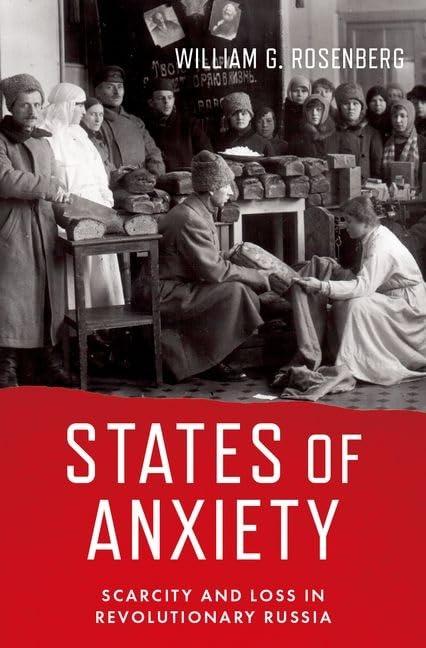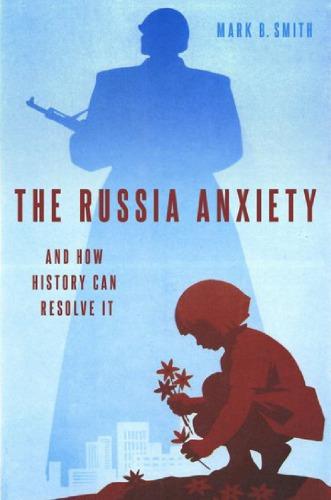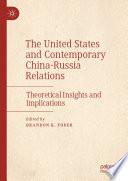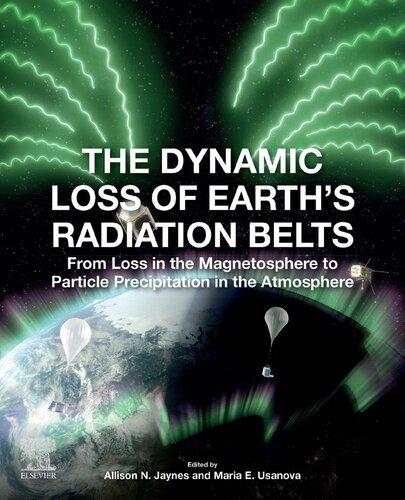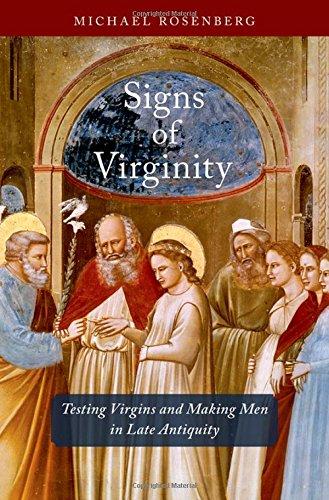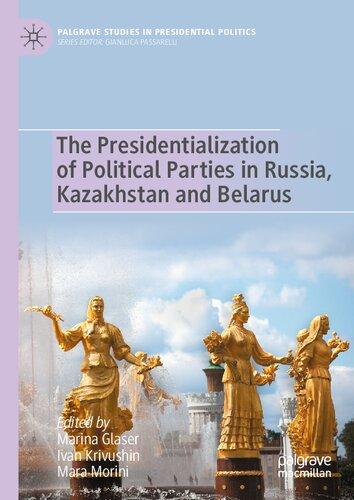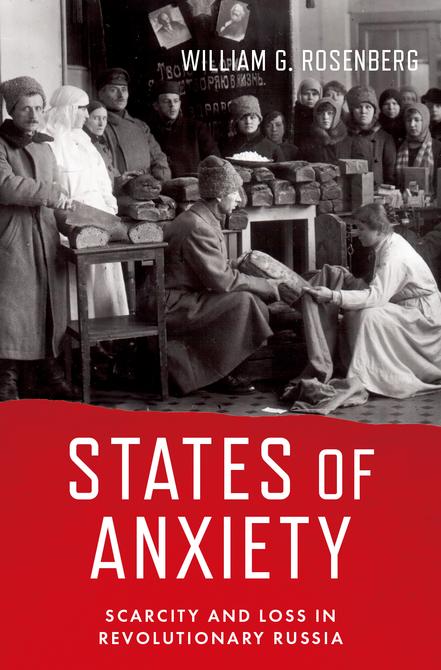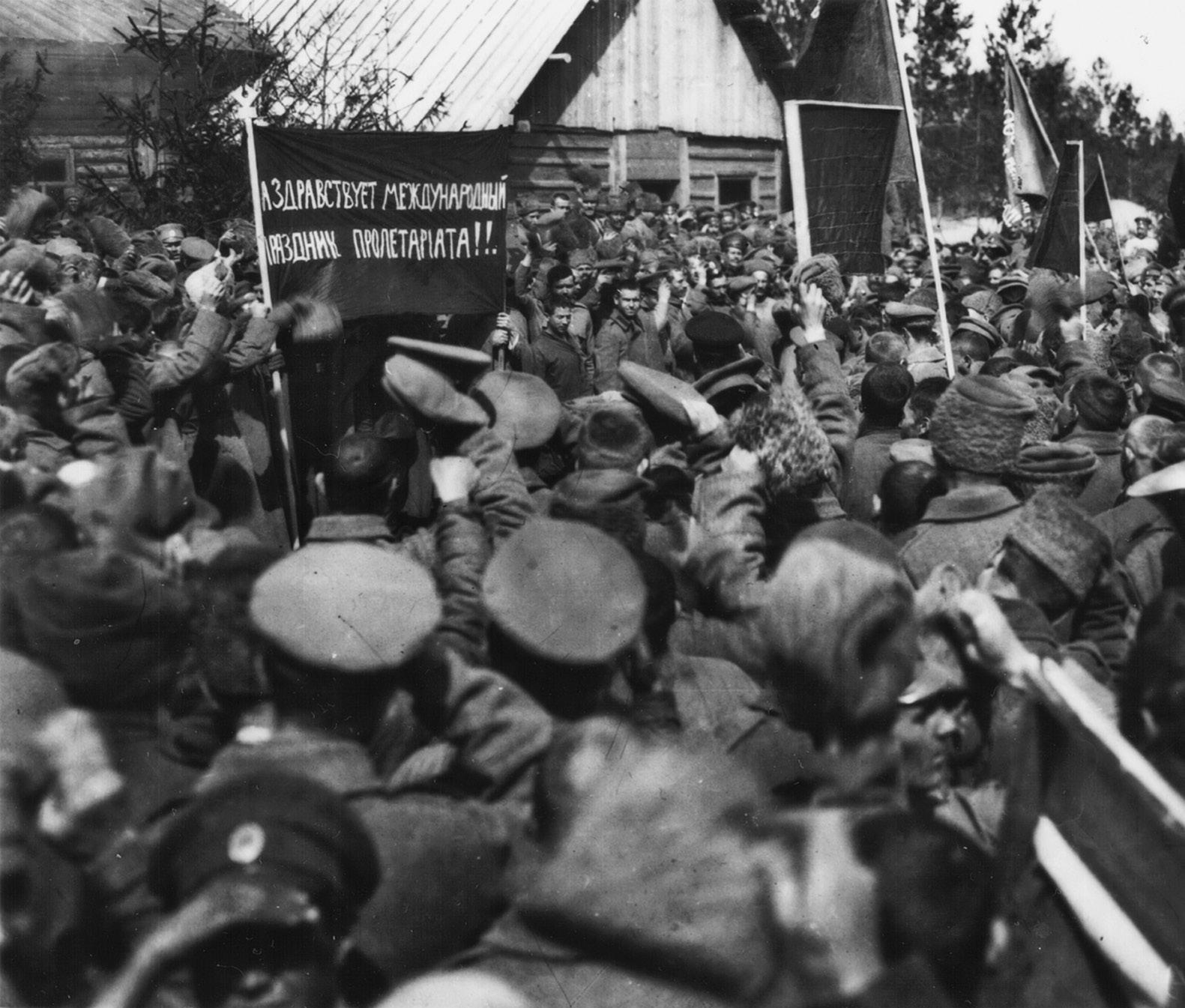States of Anxiety
Scarcity and Loss in Revolutionary Russia
WILLIAM G. ROSENBERG
Oxford University Press is a department of the University of Oxford. It furthers the University’s objective of excellence in research, scholarship, and education by publishing worldwide. Oxford is a registered trade mark of Oxford University Press in the UK and certain other countries.
Published in the United States of America by Oxford University Press 198 Madison Avenue, New York, NY 10016, United States of America.
© Oxford University Press 2023
All rights reserved. No part of this publication may be reproduced, stored in a retrieval system, or transmitted, in any form or by any means, without the prior permission in writing of Oxford University Press, or as expressly permitted by law, by license, or under terms agreed with the appropriate reproduction rights organization. Inquiries concerning reproduction outside the scope of the above should be sent to the Rights Department, Oxford University Press, at the address above.
You must not circulate this work in any other form and you must impose this same condition on any acquirer.
CIP data is on file at the Library of Congress ISBN 978–0–19–761015–2
DOI: 10.1093/oso/9780197610152.001.0001
Printed by Integrated Books International, United States of America
To Mollie, Cole, and Nadia, my three grandchildren, whom I love very much, and without whom this book might have been finished much sooner.
4.
5.
6.
7.
PART II: REVOLUTIONARY IMPERATIVES
Preface
Long in gestation, this study reflects an even longer interest in revolutionary Russia, one that goes back well before Richard Pipes suggested I study the dilemmas and plights of Constitutional Democratic liberals in this period. Young and naïve, I initially understood this period as one of great hopes and expectations, as well as even greater disappointments when the problems of revolutionary change got the better of those with the best of intentions. At that long ago time, politics, parties, and political ideologies dominated our conceptions of revolutionary upheaval. They also centered a great deal of the available evidence. (My army career took a nosedive when I continued my subscription to Pravda.) The closest I could get to a topic that might gain me access to materials in the USSR was the “crisis of those at the top”: krizis verkhov. The Lenin Library in Moscow and the Saltykov-Shchedrin Library in Leningrad contained a wealth of relevant material, even if archives for the period and all that followed were tightly shut. I well remember one librarian in Moscow who refused to give me the copies of the Kadet Party’s journal in 1917 until she had finished reading them. Censorship was not the issue. Curiosity and the excitement of discovery was.
Much older now (if not necessarily much wiser), I continue to admire the remarkable and progressive changes many tried to effect in the revolutionary period in areas like penal theory and the law, civil marriage, and the emancipation of women from the church and their husbands, and even (or even especially) literature, theater, art, and architecture. Some utopian visions were clearly quite admirable in the first and short-lived phase of Russia’s and the Bolsheviks’ cultural revolution. A print of the Malevich painting Peasant Women still adorns one of my walls. (A print of Jack Kollmann’s remarkably spiritual Russian photographs adorns another.) The nature and magnitude of individual and collective catastrophe in this period became an ineffable background noise, something to be recognized statistically but for which the necessary evidence for full description was not readily at hand. Politics continued to dominate much of our thinking, especially during the 1960s, when the antiwar protests focused overwhelmingly on political change, their social and cultural elements still largely marginal in importance.
My own thinking began to change as I struggled in this period with the dilemmas of Russian liberals, hoping they might give some insight on the contemporary upheavals. What was clear as I finished that book was not that Kadet efforts to create a democratic political order and institutionalize the values of civil rights and liberties were not admirable. It was that their politics had increasingly
little relation to the socioeconomic actualities of Russia’s revolutionary moment, nor to the effects the most destructive war in history may have had on the revolution’s culture of violence. As a result, Charles Tilly’s informal gatherings at Michigan and Leopold Haimson’s seminal work and his seminars at Columbia both drew my attention. Joining an increasing (and increasingly perspicacious) cohort, I began seriously to work on Russian labor activism with Diane Koenker. By the time that book was finished, Soviet Russia was again in a full-fledged political revolution, although just as in the period 1914–22, its social, economic, and cultural dimensions—and especially the current and future effects of scarcity and loss—were not readily apparent.
It should be obvious that this study reflects the influence of many teachers, scholars, and students, far too many people to acknowledge individually. While the bibliography lists only cited sources, many more first-rate books and articles have clearly influenced my thinking. Students at Michigan over the course of almost fifty years stimulated me greatly with their insights and critiques. Many subsequently had fine careers of their own, publishing (at last count) some forty volumes. I am gratified to think that my work with them was not likely the impediment I sometimes feared. A monthly interdisciplinary seminar by a small group of faculty throughout the 1990s kept me constantly alert to different conceptualizations and theories of social change. The remarkable series of colloquia organized by Leopold Haimson at the Institute of History in St. Petersburg brought me together with many fine Russian and non-Russian scholars who presented works in progress as well as often controversial interpretations. I am very grateful to Nikolai Smirnov, Vladimir Cherniaev, Nikolai Mikhailov, Boris Kolonitskii, and others who worked hard to ensure the seminar met regularly every three years around themes of broad historical interest. It is a great loss to many of us that the colloquia series is yet another casualty among so many of Vladimir Putin’s horrific and unconscionable war against Ukraine.
Over the course of many years Leopold Haimson was a constant source of insight, critical thinking, and friendship. That I owe loyalties to the two very different historical schools represented by Columbia and Harvard might come as a surprise to some, but the friendships and collegiality of faculty and colleagues in both places broadened my thinking despite (or perhaps because of) differences of view. So has the work I’ve done with Francis Blouin around reading archives as well as their documents. Our yearlong Sawyer Seminar brought leading postSoviet scholars and archivists together in Ann Arbor with those from many other countries. I feel confident in saying that the collection of essays and proceedings from the seminar handsomely published by the University of Michigan Press is a volume of unique value to historians and archivists alike. During the anniversary events of 2017 I had the opportunity to present parts of this study to colleagues in Cambridge, England, as well as Cambridge, Massachusetts, and in Paris, St. Petersburg, New York, Princeton, Wellesley, and the Kennan Institute in
Washington. I am grateful for the comments and criticisms I received, many of which I have taken to heart. All of the photographs come from the Central State Archive of Kinophoto Documents in St. Petersburg (TsGA KFFD SPb). I greatly appreciate the help of Alevtina Serveevna Zagorets and Oksana Igorevna Morozan in selecting and preparing them for publication.
Dan Orlovsky has read all of my chapters, Heather Hogan those on 1917. I shared notes on the esoterica of state finance in the revolutionary period with Ekaterina Pravilova, both of us much encouraged in our work by the late and revered St. Petersburg Academician Boris Vasil’evich Anan’ch. Boris Kolonitskii and Alfred Rieber gave me valuable advice as well. I am very fortunate to have had such good and supportive colleagues.
As I am for having Nancy Toff as my editor at Oxford, who encouraged me early on to make this additional contribution to a vast literature. She has been a wonderfully supportive colleague for this project as well as for an earlier volume on authority in history and the archives that originated Oxford’s History and Archives Series. Brent Matheny at Oxford has also been a great help in overseeing the production process, as were Oxford’s anonymous readers who raised important questions for me to consider. I’m very appreciative. This book is clearly much better for all these time-consuming efforts and encouragement.
As has often been the case with historians of faraway places, my family has had to tolerate my preoccupation with this project, my many absences on research trips, and the anxieties familiar to most émigré Jews originally from the region. (My mother-in-law Dora Borenstein, who left Ukraine by foot in 1920, was always relieved that I had not been “detained.”) My assurances that the greatest danger for me lay in crossing the street was to little avail. I have been blessed that for more than sixty years my remarkable wife, Elinor, stoutly resisted my efforts early on to make her into a Russianist, despite getting A’s in her Russian-language courses. Her clear-headed intelligence about this and so many other matters has allowed us to pursue two quite different and equally rewarding careers in ways that greatly enhanced both our lives and, for me, at least, provided a number of important subjects and issues to think carefully about. I am deeply in her debt.
As I am indebted to my children and grandchildren, but for different reasons. From them I’ve learned a great deal about the advantages of different life trajectories as well as impediments overinvolved parents sometimes put in their way. The same is true with the social and cultural understandings their different generations have provided. Peter and Sarah have both taught me much in very different ways. My three grandchildren, one of whom has taken to referring consistently to my “so-called” work, have given me more pleasure than they realize (along, of course, with occasional sleepless nights). As proof positive, it is a joy to dedicate this “so-called” book to them.
Islesboro, Maine, August 2022
Introduction
“Beyond the Great Stories” of Russia’s Wars and Revolutions
The hundredth anniversary of the Russian Revolution in 2017 passed virtually without notice. Several good new syntheses appeared in print, scholarly conferences and lecture series were held at leading institutes and universities, and a range of new and not so new details were added to our knowledge about what is still generally regarded as a seminal event of the twentieth century. Unlike the revolution’s seventieth anniversary in 1987, there were no animated debates about its historical meaning. Nor were there any new arguments about its worldwide implications or more than an occasional nod in the direction of its possible importance to understanding our contemporary world. Not surprisingly, this was especially the case in the Russian Federation. Lenin still lay outside the Kremlin in Red Square, preserved and observed as a historical curiosity but no longer linked in any clearly defined ways to historical memory. Sightseers passed through, poorly if at all informed about the ten days once thought to have shaken the world. In Vladimir Putin’s ahistorical regime, ceremonial linkages were more readily drawn to the imagined greatness of Imperial Russia than to the reality of Soviet gods who failed.
The Past and Present in Three “Great Stories”
The 1987 anniversary, by contrast, came at a seminal moment in Soviet history. Mikhail Gorbachev’s perestroika involved hitherto unimaginable levels of openness (glasnost’) that soon challenged the party’s formal monopoly on power, enshrined in the notorious Article Six of the Soviet Constitution. The 1987 anniversary itself was momentous in this regard not as celebration of what the Communist Party had accomplished in seventy years but precisely the reverse. The linkage between the party’s political monopoly and its legitimacy was fundamentally historical, based on an officially irrefutable conception of how history was destined to progress. Soviet socialism was imagined and secured by Leninists, but party rule was ordained and legitimized by history itself as the necessary and inevitable stage toward the ultimate communist world order. The
States of Anxiety. William G. Rosenberg, Oxford University Press. © Oxford University Press 2023. DOI: 10.1093/oso/9780197610152.003.0001
Great Story of Bolshevik triumphalism was a literally prescriptive history, now demonstrably gone wrong. Indeed, it is not too much to say that the collapse of historical essentialism in the Great Soviet Story was both the cause and the consequence of the collapse of the USSR as a functional state: cause, because the formal legitimacy of the Party’s right to rule rested on the verities of a particular understanding of history and its purported laws that was increasingly thought to be false; consequence, because having failed to serve its legitimizing purpose, the narrative itself was deemed to have no historical merit.
The origin of the Soviet Great Story preceded the revolution that enshrined it, its well known ideological and political roots stemming from nineteenth-century radical Russian populism and the spreading wave of European Marxism. So did a second Great Story that was also under siege in the 1980s, this time in connection with the two-hundredth anniversary in 1989 of the French Revolution. Here the assault involved leading French conservatives, including distinguished historians like the ex–Communist Party member François Furet, who saw revolutionary France not only in terms of its democratic and socialist underpinnings but as a source of the brutal authoritarianism reflected in the French Great Terror. Among others, Furet was soon joined by the prominent Princeton historian Arno Mayer, who linked the French and Soviet terrors to their common revolutionary origins in his heralded volume Furies. The German historian of fascism Ernst Nolte and Harvard’s Richard Pipes, who was just completing his own prodigious study of the Russian Revolution, took the argument one big step further, identifying Bolshevism as the primary source of Nazism and the Holocaust. As Queen Elizabeth came to Paris representing monarchy during the 1989 anniversary, the popular magazine Figaro insisted it was time for France to get over its revolutionary illusions. “The French Revolution is finished,” its editor wrote, “the left is dead.”1
The concept that revolution could bring democratic socialism and fulfill the unrealized promises of 1789 was also a Great Story for many leading figures in revolutionary Russia. It was articulated forcefully by the social democrat Nikolai Chkheidze, who led the moderate Menshevik faction in the Imperial State Duma before being president of the Petrograd Soviet from February to September 1917; his colleague Irakli Tsereteli, the prominent Georgian Menshevik and leading party spokesman in 1917 who joined the Provisional Government in its first coalition; and Alexander Kerensky, prime minister and minister of war in 1917
1 See, e.g., François Furet, The Passing of an Illusion: The Idea of Communism in the Twentieth Century and Interpreting the French Revolution (Cambridge: Cambridge University Press, 1981); Arno Mayer, Furies: Violence and Terror in the French and Russian Revolutions (Princeton, NJ: Princeton University Press, 2000); François Furet and Ernst Nolte, Fascism and Communism, trans. K. Golsan (Lincoln: University of Nebraska Press, 2001); Richard Pipes, paper presented to International Conference on the Russian Revolution, Jerusalem, 1987; Figaro, April 25, 1992. The French commemoration is fully discussed in Steven L. Kaplan, Farewell, Revolution: Disputed Legacies, France 1789–1989 (Ithaca, NY: Cornell University Press, 1995).
and the revolution’s best known personage after Lenin. For Russia’s democratic socialists, Hegelian and Marxist concepts of causality rooted in socioeconomic class interests and relations also structured the optimistic logic of Imperial Russia’s historical future, although, in contrast to the Bolsheviks, hardly determined it. A progressive democratic socialist future was predictable in “normal” times, but it could readily be altered by extraordinary circumstances like the First World War. Behind the democratic socialist Great Story was thus a much greater pessimism about how history might actually (as opposed to logically) unfold. Great catastrophes like the war could provoke a revolutionary upheaval before the social and cultural maturation that was necessary to sustain social democracy on politically democratic foundations. For many democratic socialists in Russia, this was the essential failure of 1789 that had ultimately brought political liberty and the possibility of equality after a tumultuous and inhumane period of upheaval whose legacies were never fully extinguished.
When the Soviet Union disappeared in 1991, only one Great Story of Russia’s revolution was left standing: that of the possibility of liberal social progress in Russia through responsible representative politics and full civil liberties. This narrative, too, was deeply rooted in the Russian past. Although it never gained massive popular support, the various strains of Russian liberalism developed in the aftermath of Russia’s Great Reforms in 1861 in representative rural welfare institutions (zemstvos) and city and town assemblies (dumas) and especially with the development of the legal profession and the modernization of Russia’s leading universities. When political parties emerged in Russia during the revolutionary upheaval of 1905, Russian liberals in the Constitutional Democratic Party (Kadets) briefly took center stage. Their leader was the prominent historian Pavel (Paul) Miliukov, well known internationally for his work on the reforms of Peter the Great and his articulation of the “statist” position in Russian historiography: the centrality of the state itself to the processes of socioeconomic modernization and political reform.
Alongside Miliukov were other notables, reflecting the various strains of the liberal movement: the progressive physician, finance specialist, and agrarian expert Andrei Shingarev, who had rocked Russia in the 1890s with his volume The Dying Village; the conservative jurist and brilliant orator Vasili Maklakov, brother of the tsar’s minister of interior; the provincial railroad expert Nikolai Nekrasov; and Alexander Manuilov, economist and rector of Moscow University. All would become ministers in 1917. Vladimir Nabokov, father of the famous writer, was also a member of the Kadet Central Committee. So were Maksim Vinaver and Sophia Panina, the first a leading advocate for Jewish rights who with others was expelled from the new State Duma in 1906 after protesting its early dissolution from across the Finnish border at Vyborg, the second renowned as a social activist and founder of the Peoples’ House (Narodnyi Dom) in St. Petersburg who
would be acquitted of anti-Soviet subversion in a riveting public trial after the Bolsheviks took power. At the core of the Kadet program were demands for universal civil rights, more democratically elected assemblies, a comprehensive resolution of the vexing question of land use and ownership, and the relaxation of impediments to industrial development and economic modernization. These were shared by liberal industrialists and others in what was called the Progressist Party, led by the Moscow textile manufacturer Alexander Konovalov, and Alexander Guchkov’s more conservative liberal party, the Octobrists, who supported the tsar’s constitutional reforms of 1905 as an important step in the right direction. In 1917, Konovalov would become Russia’s first democratic minister of trade and industry, Guchkov its first minister of war.
As it gained new traction with the Soviet fall in the 1980s and 1990s, the liberal Great Story echoed Miliukov’s statism and the broad liberal commitment to civil liberties. Firmly grounded in private property rights, the social importance of economic growth, and untethered individualism, the liberal Great Story stressed the historical necessity of a strong state to assure the equality of rights and socioeconomic opportunity against an entrenched and resistant landed gentry. In its more focused “neoliberal” forms that took hold in the Russian 1990s, even the moderate democratic socialist narrative was flawed because it imagined economic goods and social services could be equitably distributed by regulating market exchange and limiting the accumulation of personal wealth.
Here, too, the Russian Revolution was a crucible not simply of Soviet authoritarianism but of the fate of political liberty and democratic rights in circumstances of social upheaval where there was no strong state to protect them. Inside Russia and out after 1991, this neoliberal appropriation was written as a Great Story of political conspiracy, ruthless political ambition, and human tragedy, leaving no room whatsoever for celebration. In studies within and outside Russia the tropes of power, conspiracy, violence, and inhumanity were soon refashioned from their longer term antisocialist uses into elements of an older conservative narrative about revolution itself. In this old/new understanding, all sociopolitical revolutions had again become inherently problematic Great Revolutions, greatly bad. The determining effects of materiality or social and cultural mentalities and emotional states were said to be endlessly amenable to human agency, that is, ideologically conditioned politics. Everywhere revolutions occurred they were made by self-conscious, power-hungry, and ideologically driven revolutionaries, whose actions validated Hannah Arendt’s famous assertion that “freedom has been better preserved in countries where no revolution ever broke out, no matter how outrageous the circumstances of the powers that be.”2
2 Hannah Arendt, On Revolution (New York: Viking Press, 1965), 41.
In their more recent iterations, variants of the three Great Stories of 1917 are also exercises in historical appropriation that read the past through presentist lenses and assign it meaning for presentist purposes. Unless they are carefully based on new evidence, most such “reassessments” wrongly assume that current events like the end of the Soviet Union somehow change the contextualized meanings of past events, in this case Russia’s vast and traumatic upheavals between 1914 and 1922, when Lenin’s regime temporarily postponed its goal of creating communism from the ashes of world and civil war. Consciously or not, most grand narratives weave these contextualized meanings into prefigured teleologies. They create and re-create social memories of the past that are often more important as artifacts of contemporary political cultures than points of entry into really lived experience. It is the narrative telling itself that is paramount, in other words, rather than its empirical foundations. Reassessments argue that previous historians got the story wrong. Grand narratives argue that the big picture can be understood only by arguing its (big) political causes and (usually bigger) political consequences, that is, by placing it within a teleological frame.
What is wrong with reassessments and appropriations is not their presentism per se or their often undisguised moralism. All good historians try to get their stories right in part so that meanings for the present can be rightly drawn. Rather, what is wrong is the ways presentist perspectives subordinate the complex actualities of lived experience to a narrative of deliberate political or ideological purpose. The interpretative differences well known to historians of Russia between Richard Pipes (who organized his understanding of the period around political conspiracy) and Martin Malia (who focused on Marxist-Leninist ideology) are, in fact, part and parcel of the same (or very similar) perspectives. While few would deny that the Russian Revolution of 1917 was an event of great importance in the history of the twentieth century, the very recognition of what our French colleagues would call its événementiel significance conflates the complex processes of its constitution into simplifying reductions. Great events privilege grand narratives. Their focus tends to be on politics and ideology in part because these are most readily discernible within the complexities of the moment, most easily described and documented, and most readily linked to outcomes. Individual and collective social, cultural, and emotional experience is rendered unimportant, or at best relatively unimportant, to historical outcomes.3
In this connection, in an interesting historical conjuncture of its own, the breakdown of the Great Soviet Story also occurred in the midst of a prodigious outburst of postmodernist critical theory. The footnote as a scholarly device came
3 Richard Pipes, The Russian Revolution (New York: Knopf, 1990); Martin Malia, The Soviet Tragedy: A History of Socialism in Russia, 1917–1991 (New York: Free Press, 1994); Claude Romano, L’événement et le monde (Paris: Presses Universitaires de France, 1998), translated into English by Shane Mackinlay as Event and World (New York: Fordham University Press, 2009).
into particular scrutiny, as did the ways historical archives themselves structured the stories their documents evidenced through processes of acquisition, cataloging, and access. Among other challenges, this confronted the very integrity of narrative history itself as an objective telling of the past “as it really was.” Prominent American historians such as Gertrude Himmelfarb and Lawrence Stone thought critical historical theory could destroy the profession itself.4
An important if less noticed contribution to this argument in the 1990s was Robert Berkhofer’s Beyond the Great Story, referenced in this introduction’s subtitle. Taking up the challenges postmodernism was presenting to established understandings of “historical representation and truthfulness,” Berkhofer expanded on the work of Hayden White and others on the roles of narrative, rhetoric, and contextualization as implicitly historical methodologies. He focused particularly on the transition “from rhetoric to politics through the roles of voice and viewpoint in history.”5
Although Berkhofer did not stress it, the configuration of historical archives themselves illustrates his point. In Moscow, the Central State Archive of the October Revolution became the Soviet Union’s new national archive, pointing its users to the ways the revolution itself determined everything of historical importance that followed. Any document mentioning Lenin or Stalin was labeled “of exceptional value.” When the U.S. National Archives was formally created in the 1930s, Herbert Hoover dedicated its new building “to the romance of history [which] will have living habitation here in the writing of statement, soldiers, and all the others, both men and women, who have built the great structure of our national life.” Great national stories in both places were thus constructed around essential people, political parties, and their documents, as well as the institutions that supported them.6
Material Conditions, Emotional Fields, Power, and Their “Voices”
How are these issues relevant to our understanding of revolutionary Russia? With the barriers to archival access largely knocked away in Russia, and all sorts of new evidence available on the period concerning events in the provinces, the
4 See the journal pieces by Gertrude Himmelfarb and Lawrence Stone from Times Literary Supplement and Past and Present, among other contributions in Keith Jenkins, ed., The Postmodern History Reader (London: Routledge, 1997); Anthony Grafton, The Footnote: A Curious History (Cambridge, MA: Harvard University Press, 1999); Mary Poovey, A History of the Modern Fact (Chicago: University of Chicago Press, 1998).
5 R. F. Berkhofer, Beyond the Great Story: History as Text and Discourse (Cambridge, MA: Harvard University Press, 1996), vii, xii.
6 D. McCoy, The National Archives (Chapel Hill: University of North Carolina Press, 1978), 72. See the discussion in Francis X. Blouin and William G. Rosenberg, Processing the Past: Contesting Authority in History and the Archives (New York: Oxford University Press, 2011), ch. 2.
disintegration of empire, gender issues, the mobilization of nationalities, and the like, the historiography has thickened even as popular interest everywhere seems to have declined. The answer proposed by this study’s contribution to an already vast literature is twofold. First, there is the nature and effects of increasing material scarcity and physical loss between 1914 and 1922 and the complex emotional fields of insecurity and anxiety that accompanied them in a variety of ways. The actual circumstances here are difficult to assess. Material conditions varied substantially in different times and localities and even within different communities. The ostensible objectivity of statistics often cloaked inadequacies in the way they were gathered and radical differences in localities that bedeviled contemporary analysts. Moods, emotions, and emotional fields—those conditions where one’s feelings are determined in part by those perceived to be experienced by nearby others, like the patriotism of soldiers marching in parades or the contagious anger of striking workers—are inherently difficult to discern in real time, much less historically. Moreover, the key issues here are not simply, and in some ways not even primarily, the social and emotional circumstances in which Russia’s wars and revolutions were situated during this awful period of sociopsychological dislocation and political upheaval, but in the ways these conditions, in all of their uncertainties, presented very real and very complicated problems that every one of the familiar contenders for power was forced to confront. Here, too, consequently, the forms and locations of power itself become a central part of the problems themselves. Power came “out of the barrel of a gun” in revolutionary Russia, but it was also embedded in the ability to bring vital production to a halt, control the means of transport that were essential to the distribution of scarce goods, and rearrange village social relations by consensual agreement rather than laws or degrees: that fertile and unsewn land should not be private property, for example, and that peasants who had separated their holdings from community possession had to be brought back into the fold.
Second, there is the closely related matter of the languages in which these matters were expressed and addressed: the importance of understanding the roles of “voice and viewpoint,” as Berkhofer put it, in the ways leading individual and collective actors expressed or reflected them, how they might have been heard or translated into political acts and policies, and their relationship to historically imagined possibilities about Russia’s rational and logical progress toward full-fledged modernity and well-being. In ways the first few chapters of this study will describe, the very scale of the war’s carnage and its effects destabilized historical mindsets from the moment Imperial Russia entered the conflict in July 1914. It also engendered powerful new voices of its own. Scarcity, grievous loss, and the anxieties of need and insecurity themselves created an increasingly urgent need to explain and describe what for many was increasingly inexplicable and indescribable, to bring narrative coherence, in other words, to the individual
and collective convulsions on the territories of Imperial Russia’s dissolving empire.
Although important work has been done on some of these issues, especially by younger British, German, and American scholars as well as a small group of Russian historians in the post-Soviet period liberated from earlier analytical constraints, none of the Great Stories of war and revolution in Russia focuses principally on these convulsions in terms of the range of solutions that were available to political actors of all persuasions or the forms of power and languages in which they were addressed. In their various iterations, the liberal, democratic socialist, and Soviet Great Stories all maintain implicitly or directly that agency, reason, and the longer-term processes of modernization constituted the elements of progressive historical change and allowed the possibility of correcting what in Russia after 1914 seemed to go terribly wrong. In fact, modern war brought increasing dissidence, uprisings, radical political change, and the unrestrained violence of civil war. Scarcity, loss, and their accompanying anxieties grew steadily into “life in catastrophe,” as the Russian historian Igor Narskii has emotively described it, presenting contemporaries and historians alike with the daunting task of understanding and explaining how this could have happened.7
Historical Imagination and Its Mindsets
Throughout the revolutionary period in Russia one of the striking aspects of what Berkhofer calls “voice and viewpoint” was the commonality of historical thinking itself among leading political activists. In contrast to the way 1917 was marked in 2017, this seems like a quaint anachronism. Putin’s Russia and Trump’s America lack historical perspective and historical understanding. Neither looks forward or back in any clear way. For a short time after 1991, “Where is Russia going?” (Kuda idet Rossiia?) was a common question, a residue of institutionalized Soviet teleology and the title of an annual publication. By 2017, variants of Francis Fukuyama’s notion of the “end of history” seemed so firmly rooted that the question was no longer given serious attention.8 The United States and Russia both relied on presentist ideologies of social stability and individual wealth untethered by any ideologized sense of progressive historical change. For Putin and his supporters an uninformed nostalgia for an imagined past “greatness” substituted for informed understanding and even rudimentary knowledge of historical origins. Teleology was Greek philosophy. In sharp contrast, virtually
7 Igor Narskii, Zhizn’ v katastrofe (Moscow: Rosspen, 2001).
8 Francis Fukuyama, The End of History and the Last Man (New York: Free Press, 1992).
all of the principal political figures in revolutionary Russia thought historically about their circumstances and positions. Their viewpoints were situated teleologically in a clear sense of how history could and should develop, including those of the sadly incapable tsar who saw himself bearing the god-given values and three-hundred-year-old Romanov traditions borne by his “unforgettable” father, the notoriously repressive Alexander III, as he expressed it at his coronation in May 1986.
One useful way of understanding these historical mindsets is to resist distilling them into distinct political ideologies, although they are certainly amenable to such reductions, and to think of them instead as variants on what the intellectual historian and theorist Hayden White has elegantly described as “deep structures of historical imagination”: modes of thought that, consciously or not, prefigure ways historical stories are written.9 White carefully explores nineteenth-century European historical writing in these terms, focusing on Hegel, Michelet, Ranke, Tocqueville, and Burckhardt, none of whom was politically engaged in creating the histories they analyzed. During the Russian revolutionary conjuncture, in contrast, the historical imaginations of leading actors shaped the contending ways the revolutionary story was understood as it developed, as well as the ways it was initially told in documents, memoirs, and participant histories. With the presumed authority of personal experience, the renowned historian and publicist Paul Miliukov, who served briefly as foreign minister in 1917, joined Lenin’s commissar of foreign affairs and head of the Red Army Lev Trotsky and others in writing their own early versions of the Great Stories. Miliukov and Trotsky both wrote three-volume studies objectively titled History of the Russian Revolution. The populist socialist revolutionary and minister of agriculture in 1917, Viktor Chernov, went a step farther and labeled his four-hundred-plus pages The Great Russian Revolution. In the defensive and self-aggrandizing Kerensky’s case, it was The Crucifixion of Liberty and Russia and History’s Turning Point, both titles connoting that a victimized Kerensky himself stood at the apex of worldhistorical change.10
These and other historically minded activists wove the documentation they helped produce into powerful and variously convincing narratives, filtering both sources and events through the perceptions and languages of their own historical imaginations and experience. Moreover, there was an interesting commonality between them despite their sharp political differences, a consequence
9 Hayden White, Metahistory: The Historical Imagination in Nineteenth Century Europe (Baltimore, MD: Johns Hopkins University Press, 1973).
10 Paul Miliukov, The Russian Revolution (Gulf Breeze, FL: Academic International Press, 1978–87); Leon Trotsky, The Russian Revolution (London: Routledge, 1961); Viktor Chernov, The Great Russian Revolution (New Haven, CT: Yale University Press, 1936); Alexander Kerensky, Russia and History’s Turning Point (New York: Duell, 1965).
of their mutual upbringing during a modernizing age of scientific reason and discovery. For historians, the nineteenth-century Rankean seminar with its devotion to archives and textual evidence offered a science of history, Hegel’s writing the laws of history itself. Auguste Comte and the new field of sociology distilled communities and social relations in connection with the dialectical logics of change, especially (but not only) in its Marxian variants. Science was also creating maps of the mind in addition to poison gas, airplanes, and longrange artillery. Freud was popular. Russian physicians and others would soon use psychology’s new insights to invent the concept “shell shock” as they treated the unprecedented traumas of modern war.11 For virtually all of the major political actors in revolutionary Russia, historical progress was not simply a secular metaphor for social and political life. It was a shared conviction in the scientific possibility of social betterment, civil liberties, and intelligent rule.
In the liberal historical imagination broadly defined, progress was realized by rational governance, competent and well-informed officials capable of effectively managing the state. The proper use of reason and rationality moved history in a progressive direction toward individual and collective liberty and socioeconomic improvement. Reason and rationality also gave possibility to the historically inherent logics and processes of socioeconomic betterment and individual freedom. Among other elements these involved the institutional mediation of competitive social interests, the rationalization of economic production and distribution, and the structuring of state institutions to support the individual rights and legal structures rationality required—all familiar parts of liberal political programs. In its Russian revolutionary context, the liberal Great Story eschewed any notion of divine intervention or fatalism. Looking through Peter the Great’s “window on the West,” it also rejected any notion of historical inevitability or divine ordination, even if its underlying logic forecast the likelihood, not simply the desirability, of certain kinds of social and political change.
Politically, Russian liberals during the revolutionary period can be divided into conservative, centrist, and left-leaning groups, but central to their common historical imagination was thus a strong notion of historical agency that privileged the roles of history’s Napoleons and Rasputins as well as “responsible” monarchs and prime ministers. Toward this end, the authority of an enlightened autocrat could use state power to overcome the resistance of antiquated officials, outmoded social formations, ineffective economic practices, antiquated traditions, and underdeveloped cultural and socioeconomic conditions. A major step in this progressive direction occurred during the upheavals of 1905, when Nicholas was pressured into establishing a representative State Duma with
11 See esp. Jan Plamper, “Soldiers and Emotions in Early Twentieth Century Russian Military Psychology,” Slavic Review 68, no. 2 (2009): 259–83.
significant power especially over the nonmilitary state budget, albeit on a highly restricted franchise. In principle, constitutional monarchy was fully achievable in Russia, and for many, especially after the war began in 1914.
As Russia’s major liberal party, Kadets included activists of various inclinations, largely held together by a forceful Miliukov. Together they presented themselves as above partisan social interests (nadpartiinost’) and committed to progressive and enlightened statesmanship (gosudarstvenost’). Along with their more conservative liberal colleagues in the Octobrist Party they saw a strong state as a vital guard against the destructive potential of mass activism, a guarantor of law and formal authority. Centrist and more conservative liberals saw themselves struggling for the disadvantaged and less cultured social sectors whom Miliukov in 1905 urged therefore to “stay peaceful and calm.”12 For more left-leaning liberals, both within and outside the Kadet Party, their voices of reason also had to be extended toward Russia’s vital social forces (zhivye sily) as a whole, working with their democratic socialist colleagues to support worker and peasant trade unions and other associations that would ensure popular needs were rationally articulated and pursued.
In terms of social partisanship, the democratic socialist historical imagination differed sharply. This was not only because it linked state institutions to particular social (class) interests but also because its various parties and tendencies emphasized the possibility of social welfare, civil liberties, and liberal political reforms pressured from below by rational organization, social mobilization, and a leadership capable of using the instruments of state power in coalition with others to assure a stable democratic socialist order.
Here, too, there were various strains of thought and political inclination, from Menshevik social democrats tied to Russia’s rapidly growing proletariat and close to liberals in matters like civil liberties, to those like Trotsky’s mentor Iulii Martov and others who were close to Lenin’s radical internationalists. Democratic socialists also included the center and right factions of Chernov’s peasant-based Socialist Revolutionary Party, which had its roots in Russian populism. Together they commonly recognized, as all socialists did, a complementary source of power outside the purview of the state: that of the ability of workers or peasants to withhold labor to achieve political goals by strikes and protest demonstrations, or otherwise apply pressure from below to secure essential reforms from above. In this the more radical Left Socialist Revolutionaries saw themselves as heirs of the populist terrorist of the 1880s who succeeded in assassinating the Tsar Emancipator Alexander II in an effort to inspire a peasant uprising. The historically determined processes of modernization, in other
12 A full discussion is in my “Representing Workers and the Liberal Narrative of Modernity,” Slavic Review 55, no. 2 (1996): 245–70.
words, made socially instituted power a formidable rival to the monopoly on power claimed and legitimized by the state.
Underlying the democratic socialist imagination was also an explanation in events through the ways they related to each other and the more formal “laws” of historical change: Hegelian and Marxian laws of dialectical causality rooted in class interests and relationships. Thus the question of agency was also a point of difference between most democratic socialists and liberals. The argument of many moderate socialists that Russian workers and peasants had to “mature” into full consciousness of their circumstances for democratic socialism to take root limited for some the kinds of activism they and their parties should pursue. Social power had to be effectively deployed to assist in the realization of civil rights and political freedoms, not simply mobilized and unleashed.
Here the events of 1905 held broader implications than those related only to the possibilities of constitutional democracy. The tsar’s October Manifesto establishing the Duma and granting other limited rights was the consequence of massive strikes in September and October 1905, coordinated in part by a council (soviet) of delegates from many leading St. Petersburg factories. The power immanent in mass social action was demonstrable and irrefutable. But so was the power of the state to repress it with the coercive military and police forces held exclusively at its command. When strikes and demonstrations continued in Moscow after the October Manifesto, tsarist authorities bombarded the working-class districts with artillery. Casualties were extensive. When peasants pressed their demands for land and the end of burdens imposed by the 1861 reforms, Prime Minister Peter Stolypin declared martial law. Military courtsmartial in the villages hanged as many as five thousand, most likely more. In this respect, behind the democratic socialist Great Story was a strong appreciation of the (dialectical) power of reaction. Ideological optimism about the historical eventuality of socialism was tempered by a recognition of the roles malevolent actors and conspiracies could play, although these were not trivial, but of the strength and staying power of those who had so much to lose from the end of the autocratic order. Throughout the revolutionary period, socialist as well and liberal memories of 1905 strengthened the grip of history itself on viewpoints and voices.
In terms of White’s “deep structures of historical imagination,” however, many democratic socialists had much in common with their democratic liberal counterparts during Russia’s wars and revolutions after 1914. For both, teleologies of historical progress were rooted in processes of modernization: the institutional rationalization of competitive social interests, the economic processes of production and distribution, and the technological competence of the state institutions that oversaw them. The centrality of reason and rationality to historical progress thus lay behind the democratic socialist Great Story as it did
the democratic liberal one, even (and perhaps especially) in understanding and struggling against thoughts and behaviors they deemed “irrational.” Fatalism and anything remotely resembling divine intervention also had no place. More passively than in the liberal imagination, but still central as well, was the role of parties composed of politically conscious and clear-thinking activists, midwives rather than parents to progressive historical change.
Here, too, consequently, the overwhelming bulk of historical documentation produced and assembled by democratic socialists closely resembled that of the liberals. This was not simply because evidence about workers’ and peasants’ attitudes and behaviors was intrinsically difficult to collect, but because the democratic socialist Great Story was also structured around party policies, programs, actions, and the perspectives of their members. The rich trove of Menshevik materials stored unread for years in the Central Party Archive in Moscow until the 1990s contained exactly the kind of documents found in the archives of Russian liberals: official protocols of party meetings, resolutions in multiple variants, and the like.13 In Stanford, Amsterdam, and elsewhere, these materials are augmented by private correspondence, memoir materials, various brochures, and other memorabilia from private collections, all immensely valuable but almost none that inform historians about the social subjects of democratic socialist concerns.
These sorts of materials, so valuable to social historians, were brought to the foreground only in the construction of the Soviet Great Story, systematically collected and archived by the Bolsheviks after Lenin nationalized all Russian archives and private document collections in June 1918. For Lenin and his supporters, of course, the Great Story was historically determined by the social position and power of workers and poor peasants even in Russia’s relatively underdeveloped capitalist order. Radically contending against all others, it nonetheless was also centered in a mindset that imagined reason and rationality governing a socialist/communist utopia once the laws of history ran (or were pushed along) their course. For Lenin and his followers, reason was embedded in history, following Hegel and Marx, not simply applied by historical actors, and based on historical laws of causality. Agency mattered not in terms of an inevitable longer-term trajectory but in the timing of its realization. History could be shoved, and shoved forcefully, in the direction it was ordained to take if its pushers had the power to effect the radical changes it ordained. In brief, the creation de novo of Soviet-style socialism, the ultimate historicist project, validated in its revolutionary enactment both the formally rational theories of
13 See the important article by Ziva Galili, “Archives and Historical Writing: The Case of the Menshevik Party in 1917,” in Archives, Documentation, and Institutions of Social Memory, ed. F. X. Blouin and William G. Rosenberg (Ann Arbor: University of Michigan Press, 2006), 443–50.
nineteenth-century Marxism and the most irrational elements of their brutal Leninist enactment.
As the Leninist and then Soviet Great Story ideologized Marxian rationality into historical law, scientific documentation not only became the essential verification of historical explanation. It also constituted the scientific foundations of Bolshevik political legitimacy, the party’s historically determined right to rule. Evidence to the contrary was thus intrinsically dangerous. Nationalizing the archives in 1918 was also the nationalization of historical description, explanation, and truth, along with Soviet historical memory. What became the world’s largest cohort of state archivists sorted hundreds of thousands of documents or more into prescribed categories in ways that turned the radical Bolshevik historical imagination into Soviet historical reality, even as laws making the unauthorized destruction of documents a crime against state property would prove to be a huge if unintended gift to historians after the Soviet regime and its Great Story both collapsed.14
The Focus of This Study
This study goes beyond the Great Stories of the Russian Revolution by exploring 1914–22 as a period of increasingly difficult sets of problems that each successive government and each contending form of power were forced by circumstances to address. The most pressing of these had to do with the actualities and perceptions of increasing scarcities in a wide range of essential goods: food especially and other goods of “primary necessity,” as they were called in Russian; fuel for heating and industrial production; military equipment and supplies for armies and paramilitary forces; capital to sustain wages and industry; and functioning locomotives and freight cars to distribute goods. The role and effectiveness of markets and market exchange itself were closely related here, as we will see, and the difficult problem of effectively regulating prices.
A second set of problems related to the enormous scale of loss throughout the revolutionary period in all of its many dimensions: physical loss in unimaginable and unprecedented military causalities; the corresponding losses of civilians and purported enemies murdered or displaced from their homes and communities; the loss for many of social place and position; and the loss of a common sense of security in a revolutionary world described variously at the
14 See the materials in Blouin and Rosenberg, Archives, esp. those by V. V. Lapin, former director of the Russian State Historical Archive (RGIA) and his mentor, the academician B. V. Anan’ch. The story of Istpart, the Bolsheviks’ special historical commission in the 1920s, is told by Larry Holmes, Revising the Revolution: The Unmaking of Russia’s Official History of 1917 (Bloomington: Indiana University Press, 2021).
time and afterward as one of great grief, anxiety, fear, derangement, and turmoil (in Russian, gore, trevoga, strakh, ogorchenie, smuta). All of this involves traumas of various sorts and finds expression in mourning and nostalgia, despondency and despair, and sometimes fearsome rage.15 For many who survived, loss of this magnitude changed their very conception of right and wrong, empowering various sorts of violent behavior. For others, like the great writer Vladimir Nabokov, the Bolsheviks took away their childhood.16
There were, of course, other kinds of problems during these tumultuous years that political actors of all stripes had to face, many well treated in the literature: the very scale of the Great War itself, for example, as well as the bloody civil wars that followed; the ethnic and national diversity of the empire, in which all political institutions were vulnerable to continuous pulls toward autonomy and independence, especially those of political democracy; the position of revolutionary Russia in a bitterly contentious international order and the threats and effects of foreign intervention; the sharp disparities between formal and popular cultures that reinforced social difference and impeded the sense of national unity and purpose so important to Germany, France, and Britain during these difficult years. The problems related to scarcity and loss, however, were of a different nature and order of magnitude. They joined the actualities of circumstance to individual feelings and common emotional fields. They were articulated in powerful voices and violent, coercive actions. They demanded attention to perceptions as well as actualities. And most important, they defied in their scale and complexity effective solutions that correlated to the mindsets and historical imaginations of the period’s major political actors, even the most ideologized.
In this conceptualization, the political revolutions of 1917 were the consequence of a popular uprising and a successful if unexpected military insurrection. Its proximate origins began with the world war in July 1914, although, as much of the literature has rightly argued and as this study will also discuss in relevant places, its socioeconomic and cultural dimensions had deeper structural roots in Russia’s efforts to modernize politically, socioculturally, and economically, especially after the emancipation of the serfs and other important reforms of the 1860s. In important ways Russia’s first revolutionary experience in 1905 also carried residues that very much affected political and historical mindsets after 1914, as well as key events like the organization of the Petrograd Soviet in February and the network of local committees and soviets that followed. But as the first part of this study will argue, the outbreak of world war radically altered the context and circumstances of Russia’s future development, as did the brief
15 An excellent discussion is in David L. Eng and David Kazanjian, eds., Loss: The Politics of Mourning (Berkeley: University of California Press, 2003).
16 Vladimir Nabokov, Speak Memory, rev. ed. (New York: Putnam, 1966), 73.
